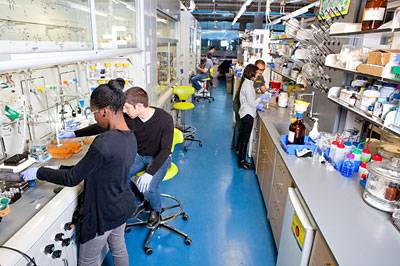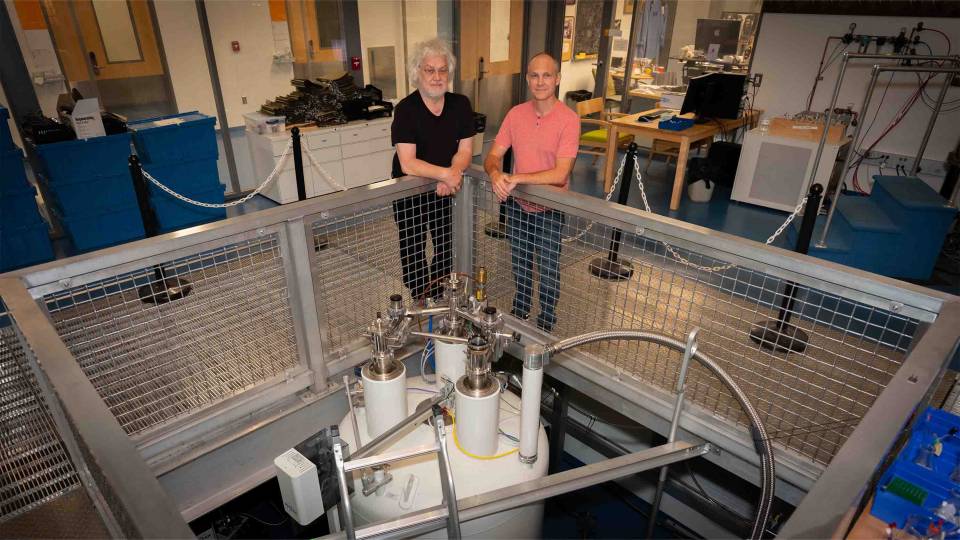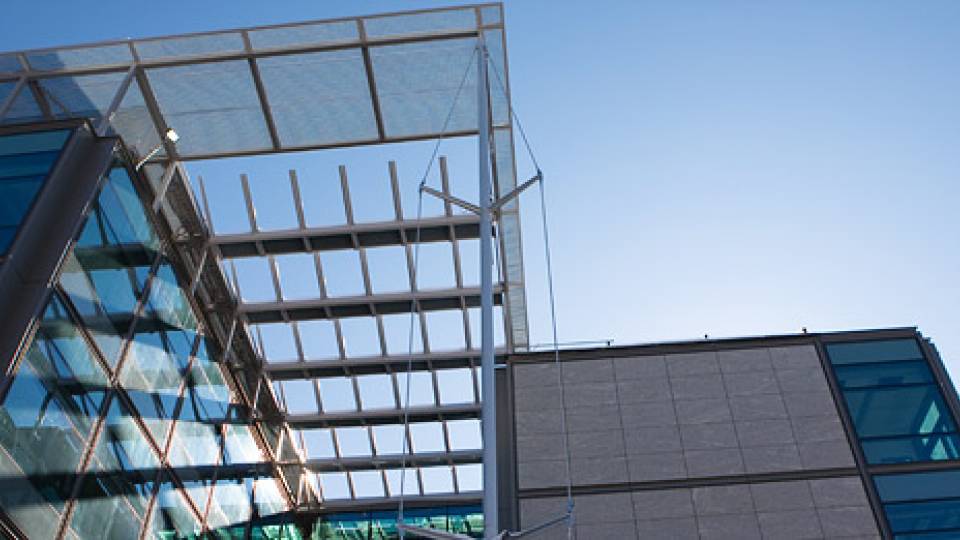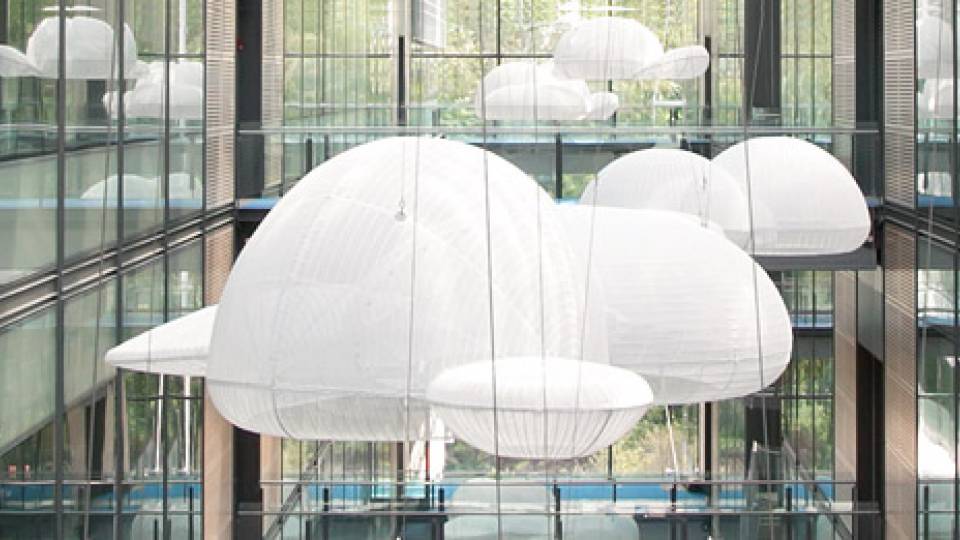There is a fresh buzz of excitement surrounding the new Frick Chemistry Laboratory, and it isn't just the building's striking facade that has people talking.
With the first full schedule of classes set to begin later this month and the laboratories ready to host their first full complement of students and researchers, the initial expressions of awe and amazement over the design of the building have been joined by new words -- opportunity, energy, innovation and growth.
Princeton researchers say the new home of the University's Department of Chemistry presents the perfect staging area to break scientific ground, to engage students by actively involving them in cutting-edge work, and -- according to the department's leader -- to provide "the best education in undergraduate chemistry in the world."

One goal of the chemistry department is to engage students by actively involving them in cutting-edge work. The new home of the department includes state-of-the-art introductory, organic and "core" teaching labs that can accommodate up to 140 students at a time. (Photo by Denise Applewhite)
"What we want is for Princeton to be the best place to conduct chemical research and to learn chemistry on a global level," said David MacMillan, the chair of the department, who is overseeing a bold expansion with recruitment of top-tier faculty. "We are going to get there by doing what Princeton does best, which is to concentrate on excellence and to focus on the best people, from professors at the height of their careers to undergraduate students taking their first major steps toward realizing their potential."
The department also aims to admit talented graduate students with the goal of training the best researchers in the world in the chemical sciences, added MacMillan, the A. Barton Hepburn Professor of Organic Chemistry.
"That's the plan, and we are not going to deviate from it," he said. "The building being probably the best chemistry building on the planet for academia is in alignment with that."
Working collaboratively, faculty and students are planning on investigating everything from new molecules and forms of energy to advanced models of catalysis and innovative materials. They also will be immersed in the classic pursuit of chemistry -- to examine the composition of substances and investigate their properties and reactions.
On the path to collaboration
Faculty and students already have begun to work at these frontiers of science where the lines between chemistry and other disciplines merge. After three years of construction, the first upper-level courses were taught in the building in the fall.
When the spring semester begins Jan. 31, the chemistry department will have completed its relocation from its former home at the old Frick laboratory -- now known as 20 Washington Road -- and Hoyt Laboratory; and the new Frick Chemistry Laboratory will be fully operational. The teaching laboratories and auditorium regularly will accommodate several hundred undergraduates, and the building will house up to 30 faculty, 30 departmental staff and 250 to 300 graduate students.

The enthusiasm about the design of the new Frick Chemistry Laboratory has grown into excitement about the first full schedule of classes the building will host later this month. (Photos by Denise Applewhite)
The modern building, comprising two wings and a central atrium, was designed to foster cross-disciplinary collaboration.
"We will be focusing on areas where chemistry mixes directly and significantly with other leading disciplines, such as biology, physics and engineering, and, notably, where they are expected to produce solutions with a pronounced, beneficial impact on society," MacMillan said.

Students and faculty in the chemistry department have begun to do work where the lines between chemistry and other disciplines merge. Li Sun, a postdoctoral researcher in Yang's group, calibrates a laser array. (Photo by Brian Wilson)
Key research areas include:
- Bio-X: Scientists will cross disciplines to engage in projects where the "X" stands for fields that intersect with many subjects in biology, such as biophysics and bioinorganic chemistry. The goal is to create or aid in the development of new medicines through a better understanding of biology at the chemical or molecular level.
- Energy: This research will seek to expand the capability of alternative energies, such as designing chemical capacitors to store photonic energy from sunlight, using hydrogen and oxygen bonds.
- Catalysis and chemical synthesis: Catalysis, the speeding up or sometimes the slowing down of the rate of a chemical reaction, is caused by the addition of some substance that does not undergo a permanent chemical change. The search for new catalysts is of wide interest in both research and industry. Researchers will undertake plans to find new catalysts to develop new chemical reactions that will reshape the way scientists think about the construction of complex molecules -- a central requirement for the discovery of new medicines.
- Materials: Collaborations will include quests for new materials with the ability to convey electrons and photons at higher speeds and capacities that will intensify as the demand for faster computers and high-quality imaging systems grows.
"These four areas represent the bulk of what chemists will be researching over the next 20 years," MacMillan said.
Facilities aid in recruiting, enable cutting-edge research
When building the Frick Chemistry Laboratory, many of the chemistry department's researchers had an opportunity to consult with designers and architects to ensure that the space would meet their needs in terms of accommodating workspace and scientific instrumentation. The building was a crucial aid in recruiting new faculty, MacMillan said.
"There is no doubt that scientists were attracted to the new building with its state-of-the-art labs and instrumentation and the opportunities it offered for enhanced collaboration, both within the department and outside it," he said.
The fact that scientists were able to design their own workspaces meant that they and their students could launch experiments directly after moving in.

Chemistry graduate student David Nagib is among the student researchers who already have begun taking advantage of the new facilities in the Frick Chemistry Laboratory. After three years of construction, the first small group of researchers moved into the building in the fall. (Photo by Denise Applewhite)
It took only a week for Haw Yang, an associate professor of chemistry, and his energized students to unpack and calibrate the instruments in his laser laboratory and begin producing data.
"I like the excitement here," said Yang, who joined the faculty from the University of California-Berkeley in 2009, attracted by the notion of being part of the evolving department and the offerings of the new building that was then under construction. "The University values deep scholarship and at the same time supports innovative, groundbreaking ideas."
Yang's research is at the forefront of physical chemistry, materials chemistry and the biophysics of single biological macromolecules. His labs feature extensive arrays of laser spectroscopic equipment, where he hopes he and his students will be able to better understand and ultimately manipulate individual molecular machines both in the well-controlled, test-tube environment and in living cells. To achieve these goals, his lab has invented and built instruments including unique imaging spectrometers, equipment that can track the three-dimensional movements of a single molecule or nano-machine in real time while making measurements. Typically spectrometers glean information by studying large groups of molecules at once and provide more general information.
Yang noted that all of the building's labs are designed for teaching, providing ample room at lab benches for undergraduate students to work side by side with faculty, postdoctoral associates and graduate students. The department-wide enthusiasm at this juncture, he said, is infectious.
"It is absolutely exciting to be part of the team that continues to create new opportunities to advance Princeton chemistry, with a pace that accelerates exponentially with every addition of a new member," he said.

In addition to working collaboratively to investigate everything from new molecules and forms of energy to advanced models of catalysis and innovative materials, faculty and staff also will be immersed in the classic pursuit of chemistry -- to examine the composition of substances and investigate their properties and reactions. In MacMillan's organic chemistry lab, a light in the center of a rack of small vials acts as a photocatalyst to accelerate chemical reactions of liquids. (Photo by Denise Applewhite)
According to Abigail Doyle, an assistant professor of chemistry, the very structure of the building lends itself to discovery.
"There's something about the light here that's inspiring," said Doyle on a recent afternoon while striding along a first-floor corridor leading to her lab. As she walked, she pointed to sunlight streaming through skylights and spilling down glass-walled corridors, offices, laboratories and meeting spaces.
"It's motivating to be a part of this -- I can look down the long hallway and see many of my colleagues," she said. The open structure suggests there are no real divisions or barriers between labs, she added. "My students are constantly bumping into students from different research groups, and their exchange of ideas is good for our science," she said. "It is not insular here."
Doyle joined the faculty in 2008. As a graduate student at Harvard University, Doyle’s research concentrated on organic synthesis and catalysis, where she made seminal contributions in the development of two new catalysis concepts. One, the asymmetric alkylation, had been viewed for a long time as a "holy grail" in the field of catalysis. Her work at Princeton is aimed at designing new and efficient ways to synthesize biologically active molecules and chemical tracers for brain imaging studies.
The research facilities on the upper floors are visible from the atrium and from the undergraduate teaching laboratories on the ground floor, she said. "I hope it will make what we do at the frontier more accessible to undergraduates and allow them to connect their coursework with new developments in the field," Doyle said.

Researchers who now call the new Frick Chemistry Laboratory home say its glass-walled corridors, offices, laboratories and classrooms inspire a productive exchange of ideas because the open structure suggests there are no real divisions between labs. (Photo by Denise Applewhite)
In addition to Yang and Doyle, who were recruited to the University by MacMillan, several other leading scientists have agreed to join the Department of Chemistry faculty.
Thomas Muir, one of the world's premier chemical biologists, this January joined the faculty from Rockefeller University. He combines tools of organic chemistry, biochemistry and cell biology in his efforts to develop a suite of new technologies that provide fundamental insight into how proteins work. The chemistry-driven approaches Muir has developed will have widespread applications for studying protein function in the postgenomic era.
Muir said he looks forward to working with department colleagues and also with faculty including Bonnie Bassler, the Squibb Professor of Molecular Biology, with whom he has long had many overlapping research interests which have led to many scientific interactions.
"It's important to have bridges between disciplines," said Muir, the Van Zandt Williams Jr. Class of 1965 Professor of Chemistry. By placing the new chemistry building in close proximity to the structures housing the Department of Molecular Biology and the University's Lewis-Sigler Institute of Integrative Genomics, Princeton is showing its commitment to interdisciplinary research, he said. And the fact that the University also has opened the Streicker Bridge pedestrian walkway connecting several science facilities gives the effort symbolic heft, as well.
Muir views the new chemistry building as "the best building for academic chemistry in the country, if not the world," he said.

When the new chemistry building is fully operational, teaching laboratories regularly will accommodate several hundred undergraduates, in addition to up to 30 faculty, 30 departmental staff and 250 to 300 graduate students, postdoctoral fellows and research staff. From back to front, undergraduates Max Manzanarez, Aprilee Velez and Adam Jaffe collaborate on an experiment in Yang's laboratory. (Photo by Brian Wilson)
This sentiment was echoed by another new addition to the faculty, Assistant Professor of Chemistry Dorothea Fiedler, who is working to understand the signaling functions of small molecule second messengers. "It is a tremendous opportunity to be joining this department now, as it is gaining such a strong momentum," said Fiedler, who came to Princeton in August 2010 and was formerly a postdoctoral fellow at the University of California-San Francisco. "The new building fosters an incredibly collegial and collaborative atmosphere, which makes starting a lab so much fun."
Paul Chirik, the Edward S. Sanford Professor of Chemistry, will join the faculty in the winter of 2011 from Cornell University. He is regarded as one of the world's foremost organometallic chemists. The new building, he said, is one of the many reasons he decided to move to Princeton. Chirik works at the intersection of the traditional disciplines of organic and inorganic chemistry and is seeking to develop chemical reactions that are energy efficient.
"We are ecstatic that these brilliant minds have joined us," MacMillan said. "We will enlist many more innovative thinkers as members of Princeton's chemistry faculty."
Building's equipment serves research and industry
Frick Chemistry Laboratory's 265,000-square-feet of space not only provides a home designed to provide a stimulating environment for teaching and research, it also houses facilities in nuclear magnetic resonance imaging, mass spectroscopy, catalysis and biochemical separations.
"Chemistry research depends on machines for analysis and purifications, as well as specialists to operate them," said Martin Semmelhack, a chemistry professor and the department's associate chair. "In many cases, the specialists are true collaborators on research projects, working closely with students and postdoctoral researchers."

Areas of the new chemistry laboratory were designed to host specialized research functions, including this nuclear magnetic resonance (NMR) lab that requires very low vibration conditions. Graduate student Nathan Jui places a sample into the NMR equipment, which allows scientists to analyze the structures of numerous compounds to a high degree of accuracy. (Photo by Denise Applewhite)
While some of the instruments in the laboratory are dedicated to particular faculty-led research groups, the building contains four shared facilities. Most are located in the basement because of research functions that require very low vibration conditions, but the feeling of open collaboration is maintained, as the facilities are visible behind glass walls. The facilities are critical to the research work of undergraduates, graduate students and postdoctoral fellows, all of whom have equal access to the technology.
A collection of seven nuclear magnetic resonance (NMR) machines serves the campus and is used by many academic collaborators. The NMR facility is designed with support areas such as the data-handling room, a sample preparation room with a sterile hood, and a meeting room for educational activities and for use by senior thesis students. The instruments are largely hands-on and can be operated by students and postdoctoral reseachers for their own experiments, although lab directors will be available for consultation and collaboration on more sophisticated applications.
"These machines are the workhorses for determining the structures of organic molecules," Semmelhack said.
Frick Chemistry Laboratory also houses a new mass spectrometry facility that accommodates several machines acquired in recent years in a spacious, open setting. Mass spectrometry is a highly sensitive technique that identifies chemicals based on their size and electrical charge.
"Mass spectrometry has a long history as an analytical tool in chemistry and has enjoyed a powerful renaissance in the last decade or so with exceedingly versatile and powerful instruments being developed every year," Semmelhack said.

Frick Chemistry Laboratory houses facilities in nuclear magnetic resonance imaging, mass spectroscopy, catalysis and biochemical separations, including this X-ray photoelectron spectrometer in Professor Steven Bernasek's lab. (Photo by Denise Applewhite)
Most of the spectrometers in the building are available to experimenters on campus. The design of the mass spectrometry facility allows for the incorporation of new instruments without serious disruption. The director of the spectrometry facility trains and supervises students to use the facility, and also carries out collaborative experiments.
The Merck Center for Catalysis and a "separations facility" maintained by the department share another all-glass enclosure. The catalysis center, the result of collaborative funding from Merck & Co. and the University, is open for research to all faculty.
While the catalysis center focuses on the development of new catalysts through efficient screening technology with automated analysis and robotic operation, the biochemical separations facility makes available technology and expertise for purification of organic compounds, with a focus on chiral separations using liquid carbon dioxide as a solvent. The director of the facility and two staff members carry out purifications primarily for the chemistry and molecular biology departments, as well as for outside users from industry.
According to MacMillan, it is all in keeping with what the University needs in order to lead the field.
"If you want to have quality, there has to be quality in every component," he said. "So you need the best people, the best students, you have to have the best infrastructure, the best building, the best staff -- every component of it has to be of such high quality."









